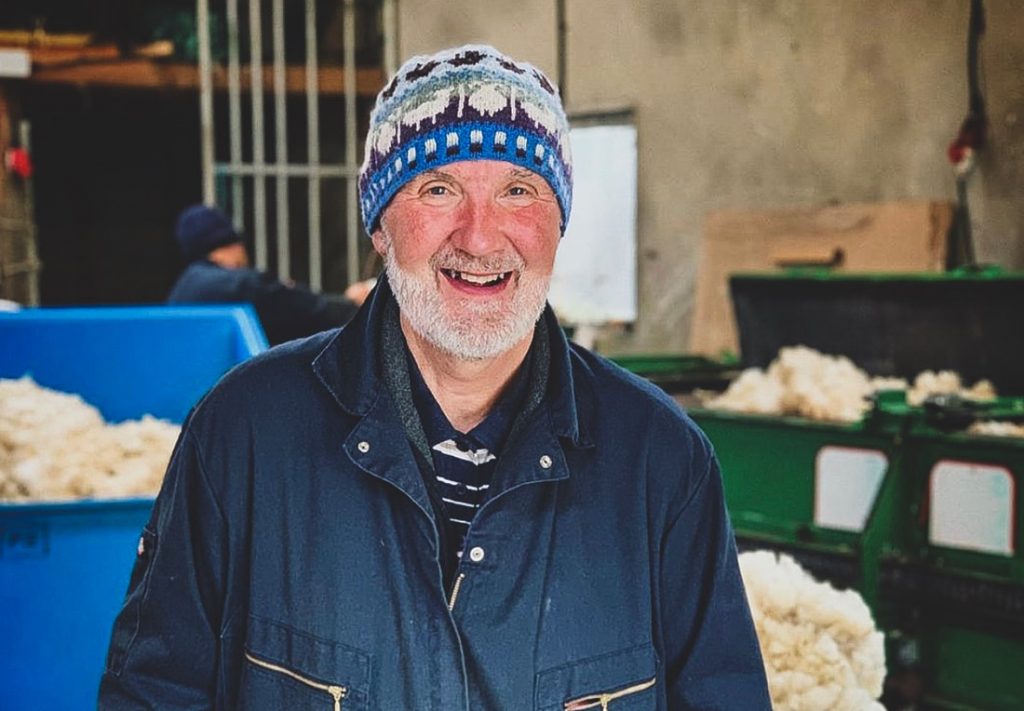I had the privilege to be involved in organising Shetland Wool Week from its beginnings right until last year, when the time was right for a change and I left my full time job with Shetland Amenity Trust. As we celebrate the tenth anniversary of the event here are some highlights and notes about how it developed over the years.

A decade ago few people imagined that knitting would go through such incredible resurgence and that Shetland would once again become an important place in terms of textiles.
For a long time the isles had been associated with distinctive knitwear that reached the royal court as well as people in faraway places but in the 70s and 80s of the last century this tradition started to decline. This was due to many reasons but the main one was the discovery of oil in the North Sea and the boom that followed. This new industry offered many exciting employment opportunities with far higher wages. So the traditional industries such as hand knitting started to decline. So much so that one generation in Shetland almost missed the tradition of learning to knit from a young age all together.
There was also the change of the way people dressed – men and women no longer wanted to wear hand-knitted woollen garments. New designs and materials such as polyester came into fashion. Looking after man-made fibre clothes was far easier than washing and dressing Fair Isle jumpers.
This trend had a detrimental effect on the cost of wool. All of the sudden, the previously valuable and precious commodity, was lying beside the roads left to rot away, as it was hardly worth selling. In particular the coloured fleeces were no longer in demand. This was a depressing time for Shetland crofters and the textile industry.
But as everything usually happens in cycles, in recent years, thankfully, the situation has been changing and Shetland yet again attracts attention for its knitwear, striking designs and most importantly Shetland wool, a truly wonderful fibre. A lot of this can be attributed to Shetland Wool Week.
The first Shetland Wool Week took place in 2010 as part of the newly launched Campaign for Wool. The campaign was an initiative of HRH the Prince of Wales and it came at a time when wool prices were at rock bottom and generally this natural fibre was not in demand.
The Prince has a keen interest in the environment, agriculture as well as supporting heritage projects and sustainable businesses through his trust. His environmentalist beliefs in the natural, sustainable and biodegradable properties of wool firmly in place when he stimulated the whole wool industry by initiating the campaign in 2010. Whilst his primary aim was to improve the position for the sheep farmer by increasing wool returns for raw wool; the result is a global campaign that unites the whole industry from the sheep farmer through spinner, manufacturer to the retailer.
The campaign started with a launch event that saw London’s historic tailoring street Savile Row transformed into a pasture upon which fifty sheep grazed. It was a combination of working with high street stores, fashion designers, journalists and other high profile people with an aim to increase interest in wool and promote this natural and sustainable type of fibre and initially it was designed to run for five years.
Another facet of the campaign was launching Wool Week in different parts of the UK. Jamieson and Smith, Shetland Wool Brokers and their parent company Curtis Wool Direct have historically had a connection with HRH so it was only logical for one of the Wool Weeks would take place in Shetland. So the first Shetland Wool Week was launched in 2010 with a small programme knitting and felting classes and other events in association with Shetland Amenity Trust and Shetland Museum and Archives.
The launch of Wool Week proved to be the perfect timing for new textile initiatives as the interest in knitting and sustainable fashion started to increase. At this point it is important to mention the late Jimmy Moncrieff, the general manager of Shetland Amenity Trust, who had a great appreciation for Shetland heritage, wool and traditional knitting skills, in particular the fine Shetland lace. Knitting fine lace was another area which was in decline, especially as hand knitting has always been extremely low paid and gradually the number of lace knitters was reducing.
Jimmy was inspired by a project in Tamil Nadu, where local artisans were supported to develop their businesses and keep their silk weaving tradition alive. After spending some time in India on his return to Shetland, full of inspiration and new ideas, Jimmy launched the Shetland Lace Project which aimed to keep the safeguard the tradition and assure fair wages for the knitters. He approached Jamieson & Smith and asked them to produce fine lace yarn, which until then had to be hand spun. The launch of the lace project coincided with the first Shetland Wool Week.
In 2011 Promote Shetland, a destination management and marketing organisation, got involved in organising the event under the auspices of Shetland Amenity Trust. Textiles and knitting seemed the perfect way to promote the place. With limited budgets for marketing and PR the obvious way to attract people was through niche markets. And back then, knitting was most certainly niche.
One of the key reasons for such the success of the event is that everyone, including competitors, works together. Along with local partners Shetland Wool Week brought together the local community of wool producers, knitters, manufacturers and craft workers and over the ten years it has become an acclaimed international event with participants travelling from as far as Japan, Australia, Alaska and South Africa.
Nobody imagined Wool Week would grow as much as it did and probably after Up Helly Aa it is the biggest event in Shetland’s busy social calendar. The participants love attending the event and many of them return on a regular basis. In fact if you want to book accommodation you need to be fast with many places booking up a year in advance. The same goes for the classes and events – when the tickets go on sale it is a stiff competition for securing your desired choice. But the wonderful thing about the event is that there are many drop-in events such as open studios or informal gatherings, where you don’t need a ticket and often these are free too. So there is always something to do for those who make their trip to Shetland without any tickets. Another thing that makes Wool Week stand out from similar events is that the programme takes place throughout the whole of Shetland including Fair Isle and Unst. Often similar events are held in one place such as a large conference centre, exhibition venue or a show grounds. So those who come to Shetland get a real taste of the place and they love the fact that they meet the locals. In fact, many friendships have been made over the past ten years.
So how is it that Wool Week became so successful? One of the most important decisions was asking Kate Davies to be the first patron of the event. Kate, a knitwear designer, researcher, writer and businesswoman, has always been a great ambassador for Shetland and thanks to her enthusiasm, expertise and support, as well as her contacts and a large following, Wool Week started being noticed outside Shetland.
Another significant development was the launch of the annual hat pattern which became the symbol of the event. The first hat was designed by Hazel Tindall and it was great to see the participants wearing their versions during the event. But it was the Baa-ble hat by Donna Smith that became a true sensation with thousands of people downloading the pattern, knitting the hat and sharing photos on social media. The first photo of the hat shared on the SWW Facebook page reached around 50,000 people which at that time was truly incredible and something to be proud of. So this way Shetland knitting went truly viral and the mailing list for the event became huge.
It’s wonderful seeing Shetland being noticed and featured in many national and international articles, blog posts and on social media. Many knitters are adding the isles at the top of their travel wish list and hope to attend the event in the future. Shetland has become a true knitting capital of the world and inspires other destinations in setting up knitting-themed events.
Another important fact about the event is that it has inspired many locals to start a career in textiles and make this a viable option. There are now many talented designers, knitwear and yarn producers as well as tour operators and guides who specialise in textile tourism.
Last year the Wool Week organisers estimated approximately around 800 attendees took part in the event and the income generated to the local economy was estimated at almost £800,000! But the most important is the promotional value of the event and people spreading the word about the place.
The dates for next year’s Shetland Wool Week are 26th September – 4th October 2020. To find out more about the event check www.shetlandwoolweek.com
SWW patrons:
2012 – Kate Davies
2013 – Felicity Ford & Tom van Deijnen
2014 – Hazel Tindall (Shwook Hat)
2015 – Donna Smith (Baa-ble Hat)
2016 – Ella Gordon (Crofthoose Hat)
2017 – Gudrun Johnston (Busta Beanie)
2018 – Elizabeth Johnston (Mirrie Dancers Hat)
2019 – Oliver Henry (Roadside Beanie)
2020 – Wilma Malcolmson (Katies’s Kep)
Timeline:
2010 – Launch of Campaign for Wool
2010 – First SWW
2012 – Kate Davies is the first SWW patron
2015 – Donna Smith’s Baable Hat becomes a sensation
2016 – SWW represented at Vogue Knitting Live New York
2016 – First SWW Annual is published
I was asked to write this article by Laurie Goodlad who is the editor of Shetland Life. The September issue of the magazine marks the tenth anniversary of Shetland Wool Week and celebrates Shetland’s vibrant textile scene.
Shetland Life showcases Shetland culture and community through in-depth features, interviews and photography. If you’re interested in a subscription please click here.
Links:
Oliver Henry’s brilliant blog about Shetland wool and his lifetime contribution to this sector
Shetland Wool Week
Knitting trips in Shetland – Shetland Wool Adventures
For inspiration, interesting information and beautiful scenes from Shetland follow Shetland Wool Adventures or My Shetland Garden on Instagram.



After taking a Fair Isle class at Michigan Fiber Festival I had to play on line. I had planned a lace class but it was canceled so took the Fair Isle, which I have actually been able to do for many years, instead and learned how poorly some American knitting teachers understand the crafts they claim to be qualified to teach. But I had a lot of fun at the festival and dream of being able to spend time in the Shetlands.
I’m sure you’d enjoy Shetland – hopefully one day you’ll be able to experience our wonderful isles for yourself. Happy knitting!